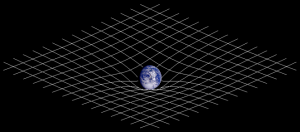While Albert Einstein is generally viewed as one of the greatest scientists to ever live, most people remain unaware of why his work was truly so groundbreaking. Einstein recognized that gravity was not a force that could be explained by Newtown’s laws of motion alone. While Newtown’s equations were great at predicting the effects of gravity, they made no attempt at actually explaining why gravity existed in the first place. This is where Einstein chose to focus his attention, eventually resulting in his theory of relativity, which stated that space and time are actually interwoven into a 4 dimensional fabric (three dimensions of space and one dimension of time). Einstein was able to recognize that gravity arises from the actual bending of this spacetime fabric.

Visualization of Spacetime Curvature. Source: Wikipedia Commons
Einstein made an astounding number of predictions during his life, with the majority of his work not being experimentally confirmed until after his death. Examples of some of his predictions include: time dilation, and gravitational lensing. One of the last predictions to remain experimentally unconfirmed was Einstein’s prediction of the existence of gravitational waves. However, on February, 11th 2016 gravitational waves were successfully detected for the first time by the Laser Interferometer Gravitational-Wave Observatory (LIGO); exactly 100 years after Einstein made his prediction about their existence.
Graviational Waves were predicted to be ripples in spacetime that would actually stretch and compress the space between two objects. Just like moving your hand through a pool of water would create ripples, so too would any object moving through the fabric of spacetime. Einstein predicted that all objects make gravitational waves; however, the more massive the object, the larger its resulting graviational waves would be.

Visualization of gravitational waves produced by two neutron stars. Source: Wikipedia Commons
This detection made by LIGO, utilized lasers (another technology based on theoretical foundations of Einstein) which made extremely precise measurements of the changes in the distance between a 4km long tunnel. By using the time that the light takes to transverse the distance, even small changes in that time can be used to detect the stretching of spacetime such as that caused by gravitational waves.
The gravitational waves detected were from a pair of black holes of 29 and 36 solar masses, located 1.3 billion light years away. These black holes were spiralled toward one another, at one point moving at half the speed of light before violently merging to form a single black hole of 62 solar masses. In instant of the merger, there were 3 solar masses of energy that were released as a gravitational wave in a fraction of second. The resulting wave in the fabric of space time is what was eventually detected by LIGO on February 11th. The resulting ripple became extremely faint by the time it reached earth, and the actual detection was from the 4km distance at LIGO changing by 1/10,000 the width of a proton.
This discovery opens up a whole new field of gravitational wave astronomy, and in essence allows for a new way to observe the universe around us. The significance of this discovery is just beginning to be realized, but it will be extremely interesting to see what we learn from future observations.
The YouTube video below is a great summary of Gravitation Waves.

Credit: PHD Comics on Youtube.
-Gulaab Sara


